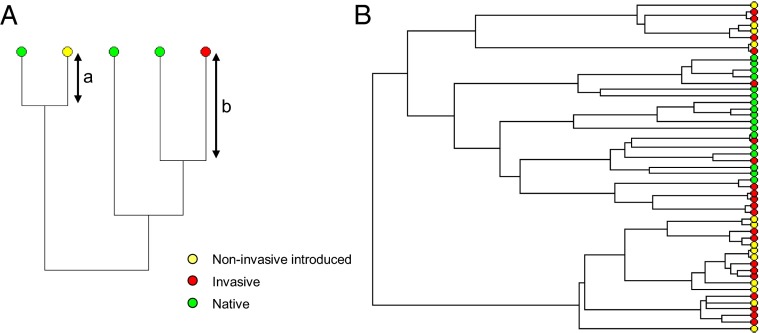Darwin’s naturalization hypothesis (DNH) proposes that nonindigenous organisms should be more successful in communities in which their close relatives are absent because this would reduce competitive exclusion and release them from enemies (1). Recently, Park and Potter (1) adopted a phylogenetic framework (Fig. 1A) to show that, contrary to the DNH, thistles introduced in California and more closely related to native species were more likely to become invasive. Although the authors’ analyses represent a step forward relative to previous analyses, a number of conceptual and methodological issues deserve consideration before discarding the DNH.
Fig. 1.
(A) Rationale of using phylogenies to test the DNH. The test is based on estimating the PD between each nonindigenous species and its closest native relative (or the average with all natives), and then assessing whether PD differ between noninvasive species (a) and invasive (b) species. (B) Example of how phylogenetic autocorrelation can affect tests of the DNH. The plotted phylogeny has been randomly generated but, like in Park and Potter (1), native species have been clustered in the same clade along with a few invasive species. Because of this nonrandom pattern, although a t test detects that invasive species are phylogenetically closer to native species than are noninvasive species (P = 0.003), contradicting the DNH, a phylogenetically corrected analysis finds no such significant effect (MCMCglmm, pMCMC = 0.57). The reason is that PD exhibits high phylogenetic signal (phylogenetic heritability = 0.89, highest probability density interval 0.80–0.97), which violates the assumption of independence of the data and increases type I errors in the t test. Note that the problem is not that there is some clustering, which is expected if there is habitat filtering, but that there are not enough independent replicates to conduct the analyses. Also note that the number of species within each category is the same than in Park and Potter (1), and that only species present in the study region are necessary to estimate PD. The analyses have been conducted with the R package MCMCglmm (http://cran.r-project.org/web/packages/MCMCglmm/index.html) developed by Jarrod Hadfield (University of Edinburgh, Edinburgh, UK).
First, Park and Potter (1) define invasiveness in terms of impact. Impact is not only the result of the abundance and distribution of the invader but also depends on the per capita effect (2). Thus, impact is not necessarily related to invasion success. Defining invasiveness in terms of abundance or spread of the species is more appropriate (3, 4), although this requires taking into account propagule pressure and time since introduction.
Second, the use of phylogenetic distance (PD) as a proxy for ecological distance is only valid when the measure is taken among species sharing the same environment, where competitive exclusion, enemy release, and habitat filtering take place (3). This aspect is particularly important considering that nonindigenous species (including thistles) often occur in disturbed communities, where natives are scarcer (5). An analysis at a larger spatial scale, as in Park and Potter (1), favors preadaptative explanations over the DNH (3).
Third, if PD accurately measures ecological similarity, why do closely related species often differ in their invasion potential? This result can reflect arbitrariness in defining invasive and noninvasive species or differences in propagule pressure. However, it can also indicate that adaptations to become invasive are little phylogenetically conserved, making PD inappropriate for estimating ecological distances. PD metrics also ignore native species that have died out locally or that have been displaced as a result of interactions with the invader, which can alter the interpretation of the patterns. The relationship between PD and niche is thus complex (4), making patterns difficult to interpret.
Finally, differences in PD can be affected by phylogenetic autocorrelation, which can arise either because lineages have diversified at varying rates or because invasive, noninvasive, and native species are clustered within the phylogeny. Rather than with a t test, autocorrelated data must be analyzed by applying phylogenetic-based methods (Fig. 1B). The alternative of using null models is also questionable. Introduced organisms were not selected at random but as the result of human interests and historical circumstances, raising important issues for statistical analysis and interpretation (5). For example, because close relatives are more likely to live in nearby regions, Park and Potter’s (1) results may simply reflect differences in the likelihood of being repeatedly introduced.
In sum, we think that Park and Potter (1) provide important guidelines for future tests of the DNH, yet additional refinements concerning the way invasion success is defined, the spatial scale chosen for the analysis, and the assumptions of the analytical approaches are required to obtain stronger conclusions.
Footnotes
The authors declare no conflict of interest.
References
- 1.Park DS, Potter D. A test of Darwin’s naturalization hypothesis in the thistle tribe shows that close relatives make bad neighbors. Proc Natl Acad Sci USA. 2013;110(44):17915–17920. doi: 10.1073/pnas.1309948110. [DOI] [PMC free article] [PubMed] [Google Scholar]
- 2.Parker IM, et al. Impact: Toward a framework for understanding the ecological effects of invaders. Biol Invasions. 1999;1(1):3–19. [Google Scholar]
- 3.Thuiller W, et al. Resolving Darwin’s naturalization conundrum: A quest for evidence. Divers Distrib. 2010;16(3):461–475. [Google Scholar]
- 4.Diez JM, Sullivan JJ, Hulme PE, Edwards G, Duncan RP. Darwin’s naturalization conundrum: Dissecting taxonomic patterns of species invasions. Ecol Lett. 2008;11(7):674–681. doi: 10.1111/j.1461-0248.2008.01178.x. [DOI] [PubMed] [Google Scholar]
- 5.Duncan RP, Blackburn TM, Sol D. The ecology of bird introductions. Annu Rev Ecol Evol Syst. 2003;34:71–98. [Google Scholar]



